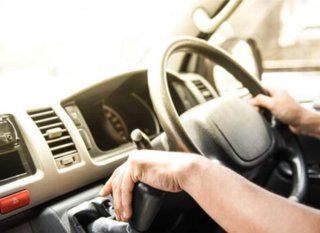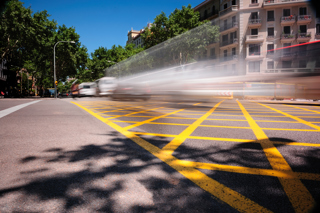There was a decrease in the number of drivers found guilty for speeding last year, but an increase in those sent for a speed awareness course, new figures show.
Some 203,801 drivers were found guilty of a speed limit offence, a decrease of 8% compared to the previous year, but an increase of 85% since 2011, according to the newly published Department for Transport (DfT) data.
The figures also show that 1.78 million drivers attended a speed awareness course in the UK, a 9% increase when compared to the previous year, and an increase of 131% since 2011.
Line chart showing the number of fixed penalty notices issued for speeding in England and Wales up to 2022, the number of people who are found guilty of speed limit offences in England and Wales up to 2023 and the number of people who attended speed awareness courses up to 2023. Source: DfT
In 2023, under free-flowing traffic conditions, 44% of car drivers exceeded the speed limit on 30 miles per hour (mph) roads compared to 9% on national speed limit single carriageway roads and 45% on motorways.
The figures from the DfT are based on speed data from a sample of its automatic traffic counters, chosen to exclude locations where external factors might restrict driver behaviour (for example junctions, hills, sharp bends and speed cameras).
Vehicles travelling at a speed higher than their applicable speed limit are defined as “exceeding the speed limit”.
| Road Type | Cars | LCVs (vans) | Articulated HGVs | Rigid HGVs | Short Buses | Long Buses | Motorcycles |
|---|---|---|---|---|---|---|---|
| 30mph roads | 44% | 45% | 36% | 37% | 24% | 30% | 51% |
| National Speed Limit Single Carriageways | 9% | Not available | 36% | 40% | 46% | 50% | 25% |
| Motorways | 45% | 47% | 2% | Not available | Not available | Not available | 55% |
In general, over the longer term there has been a slow decrease in the percentage of vehicles exceeding the speed limit on 30mph roads and relatively little change on motorways.
This is based on a comparison of the average for the five years from 2011 to 2015 with the average for 2017, 2018, 2019, 2022 and 2023 (the latest available five years excluding 2020 and 2021).
Compliance levels in 2020 and 2021 were affected by the coronavirus pandemic, these years had lower levels of speed limit compliance which may be partly attributed to lower traffic levels seen throughout Great Britain during this time.
Car compliance with speed limits
The histograms show the distribution of car speeds on 30mph roads, national speed limit single carriageways and motorways and three bar charts showing the percentages of cars exceeding the speed limit and exceeding the speed limit by 10mph or more on each of these road types. Source: DfT
Under free-flowing conditions, 44% of cars exceeded the speed limit on 30mph roads, 9% did so on national speed limit (NSL) single carriageways and 45% did so on motorways.
The percentage of cars that exceeded the speed limit by over 10mph was 4% on 30mph roads, 1% on NSL single carriageway roads and 8% on motorways.
Over the longer term, the percentage of cars exceeding the speed limit decreased on 30mph roads from an average of 55% during 2011 to 2015 to 50% during 2017 to 2023.
There was relatively little change in cars exceeding the speed limit on motorways (48% during 2011 to 2015 and 47% during 2017 to 2023).
LCV compliance with speed limits
The two histograms show the distribution of van speeds on 30mph roads and motorways and two bar charts showing the percentages of vans exceeding the speed limit and exceeding the speed limit by 10mph or more on each of these road types. Source: DfT
The DfT data shows that under free-flowing conditions, 45% of vans exceeded the speed limit on 30mph roads and 47% did so on motorways.
The percentage of vans that exceeded the speed limit by over 10mph was 5% on 30mph roads and 10% on motorways
Over the longer term, the percentage of vans exceeding the speed limit decreased on 30mph roads from 58% during 2011 to 2015 to 52% during 2017 to 2023.
There was little change in the percentage of vans exceeding the limit on motorways (49% during 2011 to 2015 and 48% during 2017 to 2023).
Articulated HGV compliance with speed limits
The three histograms show the distribution of articulated HGV speeds on 30mph roads, NSL single carriageways and motorways and three bar charts show the percentages of articulated HGVs exceeding the speed limit and exceeding the speed limit by 10mph or more on each of these road types. Source: DfT
Under free-flowing conditions, 36% of articulated HGVs exceeded the speed limit on 30mph roads, 36% did so on NSL single carriageways and 2% did so on motorways.
The percentage of articulated HGVs that exceeded the speed limit by over 10mph was 2% on 30 mph roads, less than 1% on NSL single carriageway roads and less than 1% on motorways
The low proportion of articulated HGVs exceeding the speed limit on motorways may be influenced by legislation requiring all HGVs to be fitted with devices limiting their speed to 56mph, says the DfT.
Over the longer term, the percentage of articulated HGVs exceeding the speed limit on 30mph roads decreased from 46% during 2011 to 2015 to 41% during 2017 to 2023, while on motorways it remained at around 1%.
Rigid HGVs compliance with speed limits
The two histograms show the distribution of rigid HGV speeds on 30mph roads and NSL single carriageways and the two bar charts showing the percentages of rigid HGVs exceeding the speed limit and exceeding the speed limit by 10mph or more on each of these road types. Source: DfT
Under free-flowing conditions, 37% of rigid HGVs exceeded the speed limit on 30mph roads and 40% did so on NSL single carriageways.
The percentage of rigid HGVs that exceeded the speed limit by over 10mph was 3% on 30mph roads and 3% on NSL single carriageway roads.
The proportion of rigid HGVs significantly exceeding the speed limit on NSL single carriageways may be influenced by legislation requiring all HGVs to be fitted with devices limiting their speed to 56mph.
Over the longer term, the percentage of rigid HGVs exceeding the speed limit on 30mph roads decreased from 53% during 2011 to 2015 to 44% during 2017 to 2023.
Statistics on compliance levels on motorways cannot be produced, says the DfT, because there are significant numbers of these vehicles both above and below the 7.5 tonne gross weight threshold, which are subject to different motorway speed limits.
DfT data does not collect weight information to enable vehicle data to be matched to the applicable speed limit.
Speed limit compliance by time of day
Seven line charts showing the percentages of cars, vans, articulated HGVs, rigid HGVs, short buses, long buses and motorcycles exceeding the speed limit by time of day on 30mph roads, NSL single carriageways and motorways. Source: DfT
Most vehicle classes on all three road types saw a higher percentage of vehicles exceeding the speed limit during the night (between 6pm and 5am the following day) and a lower percentage during the day (between 6am and 5pm)
On 30mph roads the percentage of cars exceeding the speed limit during the day was 43%, compared to 59% exceeding the speed limit during the night.
On NSL single carriageways the percentage of cars exceeding the speed limit during the day was 9%, compared to 22% exceeding the speed limit during the night.
On motorways the percentage of cars exceeding the speed limit during the day was 42%, compared to 44% exceeding the speed limit during the night.
Potentially lower levels of road traffic in the night could allow for higher levels of speed limit exceedance.
Speed limit compliance by day of week
Seven bar charts showing the percentages of cars, vans, articulated HGVs, rigid HGVs, short buses, long buses and motorcycles exceeding the speed limit on weekdays and weekends on 30mph roads, NSL single carriageways and motorways. Source: DfT
For most vehicle classes and road types, the percentage of vehicles exceeding the speed limit on weekends were higher than the percentage of vehicles exceeding the speed limits on weekdays.
On 30mph roads, 42% of cars exceeded the speed limit on weekdays, compared to 48% on weekends.
On NSL single carriageways, 9% of cars exceeded the speed limit on weekdays, compared to 11% on weekends.
On motorways, 43% of cars exceeded the speed limit on weekdays, compared to 48% on weekends.
Exceeding the speed limit by day of the year
Seven line charts showing the percentages of cars, vans, articulated HGVs, rigid HGVs, short buses, long buses and motorcycles exceeding the speed limit by day of the year on 30 mph roads, NSL single carriageways and motorways. Source: DfT
For most vehicle types, there were generally only small differences in speed limit compliance throughout the year.
This is despite seasonal factors such as differences in light or weather conditions which may affect speed limit compliance through the year, particularly for motorcycles.

































Login to comment
Comments
No comments have been made yet.